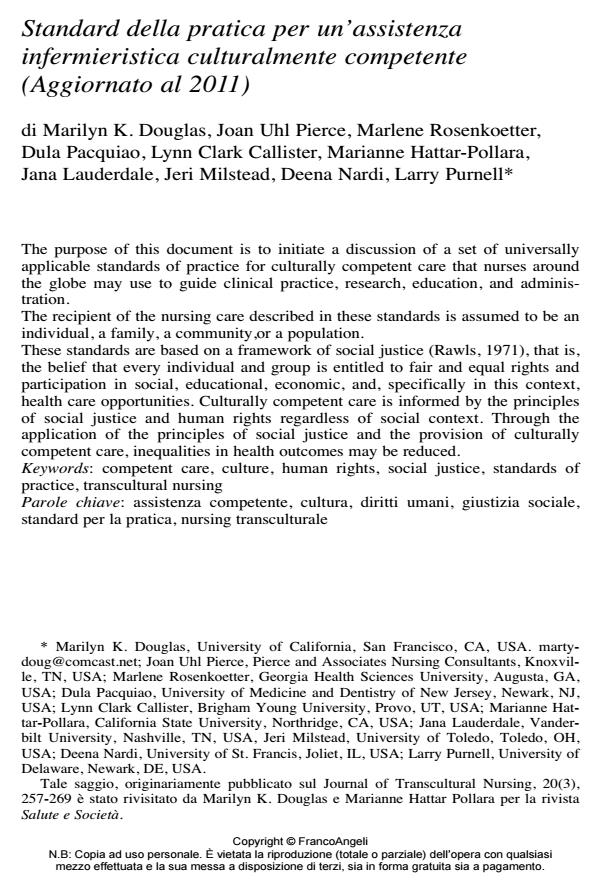Standard della pratica per un’assistenza infermieristica culturalmente competente (Aggiornato al 2011)
Journal title SALUTE E SOCIETÀ
Author/s Marilyn K. Douglas, Joan Uhl Piercie, Marlene Rosenkoetter, Dula Pacquiao, Lynn Clark Callister, Marianne Hattar-Pollara, Jana Lauderdale, Jeri Milstead, Deena Nardi, Larry Purnell
Publishing Year 2013 Issue 2013/3
Language Italian Pages 34 P. 33-66 File size 165 KB
DOI 10.3280/SES2013-003004
DOI is like a bar code for intellectual property: to have more infomation
click here
Below, you can see the article first page
If you want to buy this article in PDF format, you can do it, following the instructions to buy download credits

FrancoAngeli is member of Publishers International Linking Association, Inc (PILA), a not-for-profit association which run the CrossRef service enabling links to and from online scholarly content.
The purpose of this document is to initiate a discussion of a set of universally applicable standards of practice for culturally competent care that nurses around the globe may use to guide clinical practice, research, education, and administration. The recipient of the nursing care described in these standards is assumed to be an individual, a family, a community,or a population. These standards are based on a framework of social justice (Rawls, 1971), that is, the belief that every individual and group is entitled to fair and equal rights and participation in social, educational, economic, and, specifically in this context, health care opportunities. Culturally competent care is informed by the principles of social justice and human rights regardless of social context. Through the application of the principles of social justice and the provision of culturally competent care, inequalities in health outcomes may be reduced.
Keywords: Competent care, culture, human rights, social justice, standards of practice, transcultural nursing Parole chiave: assistenza competente, cultura, diritti umani, giustizia sociale, standard per la pratica, nursing transculturale
- Guidelines for Culturally Effective Psychiatric-Mental Health Nursing Worldwide Deena A. Nardi, in Journal of Psychosocial Nursing and Mental Health Services /2014 pp.3
DOI: 10.3928/02793695-20140331-99
Marilyn K. Douglas, Joan Uhl Piercie, Marlene Rosenkoetter, Dula Pacquiao, Lynn Clark Callister, Marianne Hattar-Pollara, Jana Lauderdale, Jeri Milstead, Deena Nardi, Larry Purnell, Standard della pratica per un’assistenza infermieristica culturalmente competente (Aggiornato al 2011) in "SALUTE E SOCIETÀ" 3/2013, pp 33-66, DOI: 10.3280/SES2013-003004